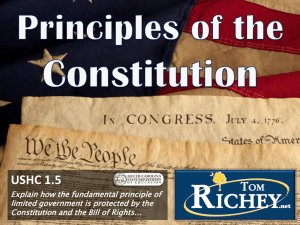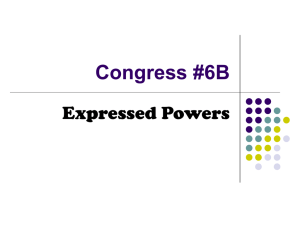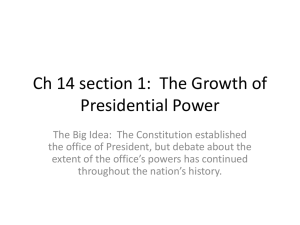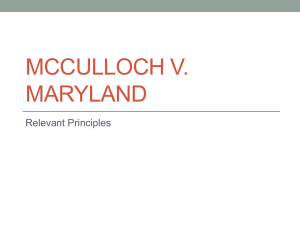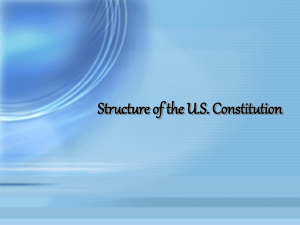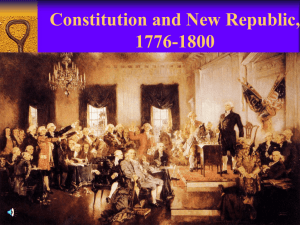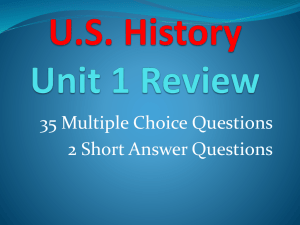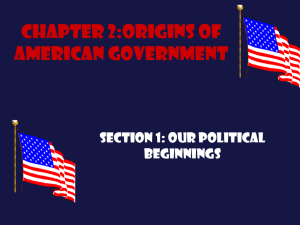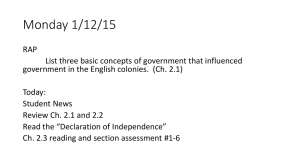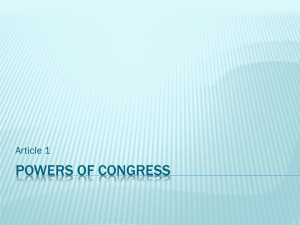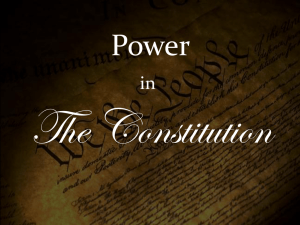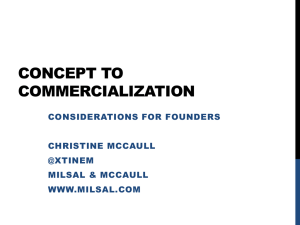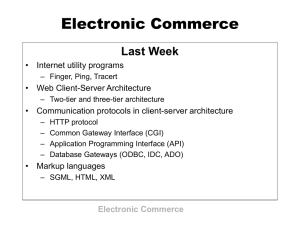Structures of the Constitution
advertisement
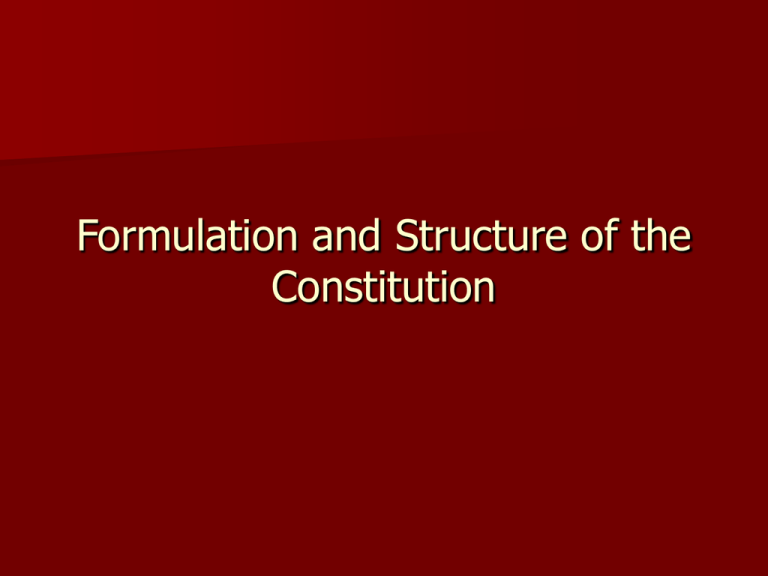
Formulation and Structure of the Constitution The Path To Independence As a result of the French and Indian War (also known as the 7 years war), Britain gained extensive new territory in North America The expense of defending this newly won land, however, was overwhelming Britain, like most governments of the period, have limited ways to collect revenues (the income tax had not yet been developed) Britain reasoned that the colonists should share in this burden through tariffs and duties (such as the Stamp Act) The Path to Independence American’s respond with resentment, boycotts – New taxes crystallized political and philosophical values that had been evolving over time – Colonial leaders were heavily influenced by the European Enlightenment (especially John Locke who argued that governments exist to secure the rights of the people, and must derive their power from the consent of the governed) Principles vs. Interests PRINCIPLES: • No taxation without representation • Government must gain its power through the consent of the governed INTERESTS: • Political and economic dependence on a colonial power was intolerable Evolution of Conflicting Interests 1776 Pro-revolution Anti-Revolution 1787 Federalists Anti-Federalists Today Democracts Republicans As Madison noted in The Federalist, politics generally involves struggles among conflicting interests. Often, political principles are the weapons developed by competing interests to further their own cause. Conflict During the Revolution Five sectors of society had interests that were important in colonial politics: 1. New England Merchants 2. Southern Planters 3. “Royalists” – holders of royal lands 4. Shopkeepers, artisans, laborers 5. Small farmers The larger of these groups (merchants, planters, royalists), managed to create a political alliance that kept the more radical groups (shopkeepers, laborers, farmers) at bay. British Policies Encourage Radicalism By 1750, however, British trade and tax policies had so seriously threatened New England merchants and Southern planters that it split the political elite, allowing radical elements to expand their influence The Radicalization of the Colonists Tariffs such as the Stamp Act and Sugar Act most heavily affected New England Merchants and Southern Planters With the assistance of shopkeepers, and farmers, these groups organized boycotts and protests Events such as the Boston Massacre are used to further spread antiBritish sentiment Repeal of Stamp Act Merchants and Planters see the repeal of taxes (such as the Stamp Act) as victory and are eager to end the unrest that they had helped to start • The more radical forces, however, had by now become organized and continued to agitate for social change within the colonies • Revolutionaries such as Sam Adams emerge, providing the necessary leadership and organization to foment rebellion • The Boston Tea Party Merchants hoped the event would encourage Britain to repeal Tea Act Revolutionaries such as Sam Adams hoped to goad Britain into enacting harsh policies that would anger colonial supporters and pave the way for rebellion Britain obliges, responds with a series of tough punishments (Intolerable Acts) – Parliament considered this their only option. Tolerating lawlessness or making concessions would only further egg on the colonists. – Adams now has the tool he needs to rally support for a war against Britain Declaration of Independence 1776 – Second Continental Congress meets, appoints committee to write Declaration Philosophically, the Declaration is remarkable in its assertion that certain rights are “unalienable”, including life, liberty and the pursuit of happiness, and in its repudiation of the “divine right” of Kings Politically, the Declaration identified and focused on problems, grievances and principles that might unite the various colonial factions. Articles of Confederation • • • • • • • First attempt at Constitutional government by the Founders Concerned primarily with limiting the powers of the central government No executive branch, all federal power located in Congress, which could declare war, make treaties, but could not tax or regulate commerce between the states Members were not much more than delegates or messengers from the state legislatures Each state had a single vote Congress did have the power to maintain an army, yet it lacked the resources to adequately do it No court system to settle disputes between states Balance of Power In the New Nation Competition among the states for foreign commerce allowed European countries to play the states against each other Britain negotiated treaties with each of the thirteen states rather than the federal government, which it claimed was unable to enforce existing treaties Balance of power shifts in America as well – the prerevolutionary elite (royal land and office holders) are replaced by radicals (farmers, artisans, shopkeepers), who impose economic policies that frighten most business owners (including massive currency inflation) The Annapolis Convention (1786) Called to discuss revisions to the Articles First step towards the “Second Founding” Only five states sent delegates Resolution passed that called on Congress to “devise such further provisions as shall appear to them necessary to render the Constitution of the Federal Government adequate to the exigencies of the Union” Shay’s Rebellion Shay and a group of farmers staged a rebellion to protest the loss of their land to creditors The group attacked courthouses to prevent foreclosures on farms Neither the Massachusetts militia nor the national government was able to stop the rebellion A privately funded force had to be organized to put an end to the fighting This convinced many that bold solutions were needed to mend the country’s post-Revolution problems The Constitutional Convention (1787) 29 of 73 Chosen delegates meet in Philadelphia to amend the Articles of Confederation Faced with political strife, international embarrassment, national weakness and local rebellion, delegates commit themselves to a second founding What Motivated the Founding Fathers? Economic Self-Interest – “Beard’s Thesis”, idea put forth by historian Charles Beard that American founders were a collection of securities speculators and property owners whose only aim was personal enrichment. – The Constitution’s lofty principles were little more than sophisticated masks behind which the most venal interests sought to enrich themselves What Motivated the Founding Fathers? Political Principles: – Suggests the framers were concerned with philosophical and ethical principles and sought to devise a system of government consistent with the dominant philosophical and moral principles of the day In Truth: Combination of the two, the founders’ interests were reinforced by their principles The Convention was chiefly organized by New England merchants and Southern planters, but not all of the members of these groups hoped to profit personally (as Beard would suggest) The founders did hope to benefit in the broadest political and economic sense creating a new government capable of promoting commerce and protecting property from radical state legislatures They also sought to liberate the national government from the power of individual states, as well as insulate it from the populist forces hostile to the interests of the commercial and propertied class PART II: The Structure of the Constitution Questions faced by the Delegates: How should representation be determined? What about slavery? Who will have the power to vote? What powers should the national and state governments have? How do we protect individual rights? The Question of Representation • • • Virginia Plan First proposal presented at the Constitutional Convention, became a framework for what ultimately would become the new Constitution Representation based on population Heavily biased towards the larger (southern) states • • • • New Jersey Plan Concentrated on specific weaknesses in the Articles Argued that each state should have equal representation Benefited smaller states Smaller states threaten to leave Convention, dissolve union The Great (Connecticut) Compromise Proposed a bicameral legislature One house determined by population (House of Rep.) another giving each state an equal amount of votes (Senate) Conflicts During the Convention: Most of the conflicts during the Convention reflect the fundamental differences between the slave and non-slave states. (New England merchants vs. Southern Planters) 90% of all slaves are divided into five states: Georgia, Maryland, North Carolina, South Carolina, Virginia (where they account for 30% of the total population) Madison himself noted: – “Look to the votes in Congress, and most of them stand divided by the geography of the country, not according to the size of the states” Slavery Founders realize that some basic decisions about slavery would need to be made Northerners and Southerners eventually reached agreement through the three-fifths compromise – Slaves would count as 3/5ths of a person for the purpose of deciding representation in the House – Slaves could not vote – Although the three-fifths compromise acknowledged slavery and rewarded slave owners, nonetheless, it probably kept the South from unanimously rejecting the Constitution Goals of the New Government: 1. 2. 3. 4. Promote Commerce and Protect Property Provides the basis for National control of commerce, judicial supremacy, strong presidency Protect against “excessive democracy” The “majority faction” Madison attacks in Federalist #10 Resulted in checks and balances, bicameralism, staggered terms Identify principles that would help secure popular support Popular elections (of representatives), Bill of Rights Create a government that would not pose a threat to individual liberties and property rights - federalism, separation of powers Structures of the Constitution I. II. III. Legislative Branch Executive Branch Judicial Branch I. The Legislative Branch • • • • Members of the Senate originally selected by state legislatures (changed by 17th Amendment – 1913) Staggered terms (only onethird of all Senators are up for election at any one time) Granted most important governmental powers (collect taxes, coin money, declare war, regulate commerce) Sought to promote popular acceptance by reassuring citizens that their views would be fully represented House of Representatives Designed to be directly responsible to the people Given sole power to originate revenue bills (power of the purse) Larger, more difficult for Reps. to directly influence policy Governed by stricter rules than the Senate Senate Designed to be more aristocratic – less responsive to the people (longer terms, not directly elected) Staggered terms designed to make it even less responsive to popular pressure Given specific power to ratify treaties and approve presidential appointments Powers of Congress Doctrine of expressed powers: – Constitution grants only those powers specifically expressed (enumerated) in its text (government is limited) – To ensure an active and powerful government, Congress included the necessary and proper clause, or “elastic clause” authorizing Congress to do whatever “necessary and proper” for the execution of their powers. Powers exercised through the elastic clause are often referred to as implied powers – Any power not expressed or implied is reserved to the states (or the people) II. The Executive Branch Aimed towards creating “energy in the Executive” – Given the ability to overcome natural stalemates in the Congress – Afforded a measure of independence from the people and the other branches – Given “Inherent powers” such as recognizing ambassadors, negotiate treaties, pardon, appointment, etc. The framers hoped to create a presidency that would make the federal government, rather than the states, the agency capable of timely and decisive action Insulated from “excessive democracy” through the electoral college III. The Judicial Branch Designed to protect liberty while at the same time nationalizing governmental power Gave Supreme Court power to resolve conflicts that might emerge between state and federal laws Judges given lifetime appointments to protect them from popular politics or interference by the other branches The Supreme Court eventually assumed the power of judicial review National Unity and Power Article IV includes provisions for comity (reciprocity) between the states and among citizens – States are prohibited from discriminating against the citizens of other states in favor of its own citizens – Another means of protecting commerce and providing a free-flowing national economy Article VI includes the supremacy clause – Creates a “hierarchy of laws” – Constitution at top, states below Part III: The Fight For Ratification
